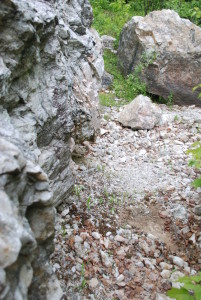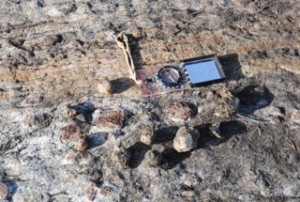Selling Rocks – Trout Creek and River Valley (Sturgeon Falls)
Why the Rocks?
By Back Roads Bill
Rocks lend color, texture and a touch of Zen to your garden. This fall many people are preparing for the spring of 2014.
Rock or scree (loose rock debris) gardens are becoming more popular. Rocks, gravel and boulders last forever and solve many landscaping dilemmas.
Scree gardens are a great way to spruce up your yard, especially if you have areas that are bare or need covering up. Even beginner gardeners can easily design a rock garden, and there is no wrong way to do it. So where should we go or find the rocks?
Selling Rocks
Imagine having a rock shop in northern Ontario? Our landscape epitomizes what the Canadian Shield is all about. The Rock Centre, on Pinewood Drive, specializes in rocks. There are many reasons why consumers are buying more rocks than ever. Jamie Fuller is the owner and their family has been in the business for more than 15 years, including owning rock quarries.
“More and more people are just getting rid of their lawns,” said Mr. Fuller. “There is a movement to create an oasis in your backyard; it has become a destination other than the trip to the camp or cottage.” He also said, “The advent of water meters and pesticide/herbicide restrictions are changing people’s minds about cutting the grass. Why have a lawn mower may be motivation enough for our aging population to stop cutting the grass.” He said once rock gardens are established there is little maintenance and “rocks last forever.” Dry river bed rocks are often chosen by consumers.
He cited some of the home scree gardens near the Osprey Golf Course, including Ted & Isla Reed, 193 Pleasantview Place. Also the start of a rock garden at 1868 McKeown, near Widdifield Secondary School, where the owner is changing the front lawn to a rock garden in transition. Now comes the fun part, picking out the rocks.
Wine and Rocks
People dislike the thought of purchasing landscaping rock from a store, since it is a natural product of the earth and should be free for anyone to use. Landscape centres would disagree of course.
Depending on where you live, you may find landscaping rock on the side of the road. There are many of these road cuts in our area, so lots of people spend their weekends on the sides of roads, collecting this free landscaping rock. Be careful if you choose to collect rocks in this manner, look both ways when crossing the highway!
You may like red and white wine; same with the rocks.
If you like the white rocks visit the abandoned Comet Mine. The Comet quartz mine was investigated for use in the electronic industry in the early 1980’s and is a small exploratory pit. Look around in the bush for errant samples from the blasting.
Take Highway 11 South to the Trout Creek exit, just less than 40 km., south of North Bay. You will end up on Main St. (old Hwy. 11). Turn left or east at the general store, you will go past the old Trout Creek hotel on the left; pass over the CN railway tracks; at the one km mark you will come to the Forestry Rd., turn south or right; set your odometer and from this turn, go approximately 8 km on this road. (If you carry on you will end up in South River, a nice drive.)
Access to the abandoned mine is on the left or north side, just before an extensive wetland surrounded by tamarack. It is a good solid back road; drive in about 300 metres and park at a landing. This is at WGS 84 Zone 17 T 634360 5092263 or N45° 58’ 14.8” W79° 15’ 56.5”. Veer left WNW for about 50 m through the hardwoods, then veer or west and you will come to the small pit.
If you are prone to red take the back roads to the River Valley garnet mine. You will drive Highway 64 North of Sturgeon Falls, to Field, cross over the Sturgeon River. Turn left or west on #539 heading to River Valley. Go through River Valley, cross over the abandoned railway line and cross over the bridge spanning the Temagami River (nice rapids photo opportunity). Travel 1.5 km to the Erana Mines Rd., turn right or north (NNE). Then travel about one km, at the fork keep left or NW. (The road to the right is the active black granite mine.) From here it is almost five km to the new black granite quarry on the west or left side; some really nice black granite rocks here on the side of the road.
Drive another 1.8 km beyond to the three way junction, travel straight or north through the jack pine plantation. You will see a ridge to the left or NW. There will be a turn left or north-west, go up the hill, you will see a ridge of poplar trees on the right; park on the flats. You will bushwhack about 100 m south (left side) to the exposed bedrock ridge with plenty of glacial striations. Travel less than 50 m NW or turn right on the bedrock; (the ridge gently falls off in a southerly direction) and you will come to some small open pits with the deep violet to red, with crystals averaging two cm in diameter set within large conglomerate chunks of rock. The garnet mine first operated in 1943 with a reincarnation in the early 1960’s. Garnet has a number of uses including the grit needed in sandpaper. The final road, up-the-hill turn is at WGS 84 17 T 563465 5168137 or N46° 39’ 49.6” W80° 10’ 13.5” and the open pits are at 17 T 563146 5168241 or N46° 39’ 53.1” W80° 10’ 28.4”.
Choose rocks in variations of sizes, and place them randomly in your garden. Rock gardens shouldn’t have patterns and specific designs; they are supposed to look like they are a fluent part of nature. One final tip, keep lawn ornaments to a minimum, if you include them at all; that huge butterfly pinwheel will not only be distracting but will look gaudy; (a good application in context for the word as the rocks are more modest).


